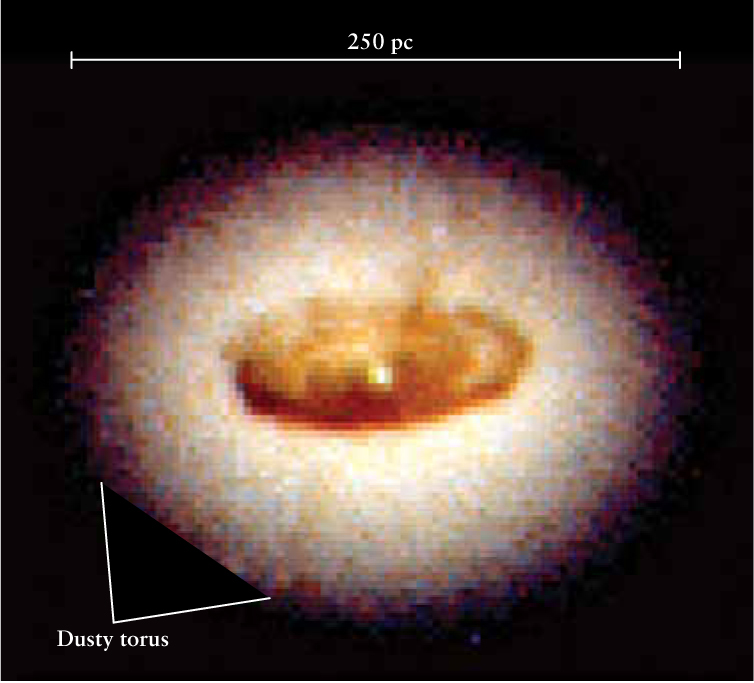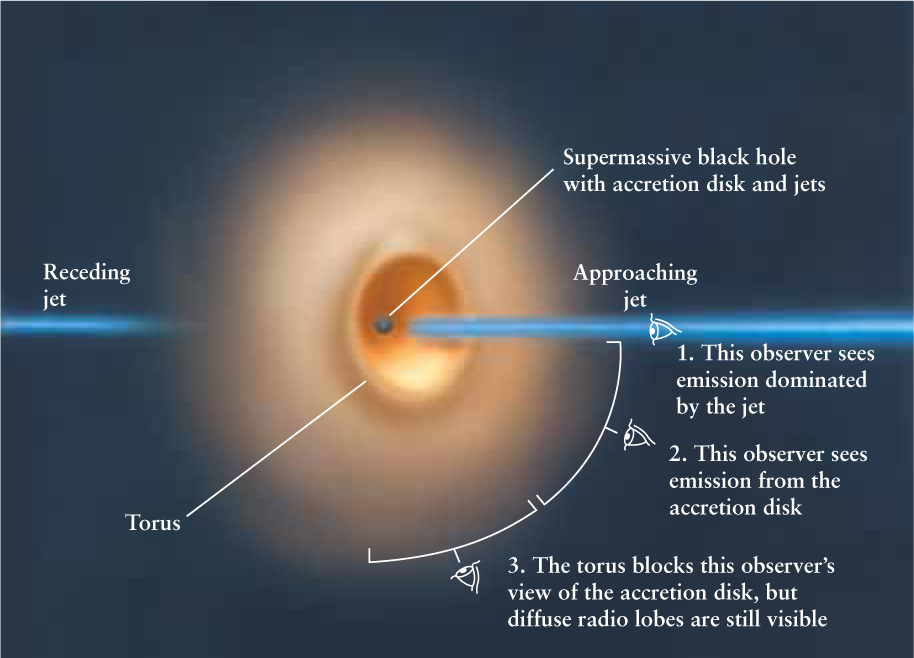24-4 The unified model explains much of the diversity of AGN
Untangling the mystery of active galactic nuclei was extraordinarily difficult because AGN can appear very different from each other. In fact, it took several decades before researchers determined that the diverse group of AGN could all be “unified” into one physical model. Box 24-1 describes some different properties of AGN and their naming conventions. For example, one AGN, such as 3C 273, might have a visible spectrum with unusually strong and broad hydrogen emission lines (Figure 24-3) and show strong variability (see Figure 24-5). Another AGN might have very weak and narrow hydrogen emission lines with little variability. Given the difficulty of explaining how one type of “central engine” powering their luminosity could explain such diverse behavior, these observations suggested—incorrectly—that these two AGN contain different emission mechanisms. In fact, the unified model explains how different AGN, at their core, are fundamentally the same.
BOX 24-undefined TOOLS OF THE ASTRONOMER’S TRADE
The Diversity of AGN
Active galactic nuclei, or AGN, come in two unique varieties: those with radio jets and lobes (called radio-loud), and those without (called radio-quiet). Radio galaxies, like those in Figure 24-1 and Figure 24-8, are radio-loud AGN. About 10% of quasars are radio-loud, and, when observable, their host galaxies are elliptical. The remaining quasars are radio-quiet and, when observable, their hosts are spiral galaxies. (It is not understood why radio-loud and radio-quiet AGN are each found in ellipticals and spirals, respectively—this remains a mystery.)
The light emitted from jets is focused into a strong beam because the jets’ emitting plasma travels near the speed of light. In cases where the jets are pointed almost directly toward Earth, the jets’ beamed emission swamps the usual AGN emission, and these objects have a very different spectrum (often without any detected emission lines). These objects are called blazars, and while originally thought to be distinct from quasars due to their different appearance, they are now understood as special cases of jet alignment with our line of sight from Earth.
Quite similar to quasars, Seyfert galaxies also show bright, compact nuclei with emission lines. Eventually, it was realized that both quasars and Seyfert galaxies contain the same type of object, and both are examples of AGN. Historically, bright and distant AGN, where the host galaxies were not initially observed, are called quasars; nearby cases where the host galaxies can be easily seen are called Seyfert galaxies.
Seyfert galaxies and quasars also come in two further varieties: those with strong broad hydrogen emission lines (called Type 1) and those with weak narrow hydrogen emission lines (called Type 2). Furthermore, the continuum emission in the Type 1 AGN can vary significantly in brightness, whereas the continuum in the Type 2 AGN does not vary.
Explaining Type 1 and Type 2 AGN in terms of the same central engine was a major advance in understanding quasars, and the explanation is called the unified model. Ultimately, appearing as Type 1 or Type 2 depends on the line of sight, as shown in Figure 24-13. The table below summarizes some properties of AGN; the modern distinction of Type 1 or Type 2 is in parenthesis after the object’s name.
| Intrinsic Luminosity | |||||
|---|---|---|---|---|---|
| Object (Type) | Found in which type of galaxy | Strength of radio emission | Type of emission lines in spectrum | (watts) | (Milky Way Galaxy = 1) |
| Blazar (1) | Elliptical | Strong | None | 1038 to 1042 | 10 to 105 |
| Radio-loud quasar (1) | Elliptical | Strong | Broad | 1038 to 1042 | 10 to 105 |
| Radio galaxy (2) | Elliptical | Strong | Narrow | 1036 to 1038 | 0.1 to 10 |
| Radio-quiet quasar (1) | Spiral or elliptical | Weak | Broad | 1038 to 1042 | 10 to 105 |
| Type 1 Seyfert | Spiral | Weak | Broad | 1036 to 1038 | 0.1 to 10 |
| Type 2 Seyfert | Spiral | Weak | Narrow | 1036 to 1038 | 0.1 to 10 |

A Dusty Torus Around a Supermassive Black Hole This immense doughnut of dust and gas orbits the black hole at the center of the active galaxy NGC 4261. Radio jets emerge perpendicular to the plane of this torus (see Figure 21-16).
The astronomer Robert Antonucci (now at University of California, Santa Barbara) put together the main picture of the unified model and uncovered its key ingredient: a thick dusty doughnut-shaped torus around the central engine’s accretion disk. The presence of such a torus seems to be a natural result of the overall accretion process. One such dusty torus is shown in Figure 24-12. Rather than emitting visible light, the dusty torus can block light from passing through it from the central engine. In contrast to the torus, the accretion disk within the torus is much too small to be seen—its emission appears pointlike—so no structural features of an accretion disk have ever been imaged.
If there were no dusty torus around an accreting supermassive black hole, an observer could view such a black hole from any angle and see the intense radiation from the accretion disk. But, as a result of the torus, from certain angles the torus blocks the view of the accretion disk. This idea offers a single explanation for several types of seemingly different active galaxies.
Figure 24-13 illustrates the unified model for a luminous active galactic nucleus with radio jets. If an imaginary observer looks straight down the axis of the jet (#1), the observed radiation is dominated by the jet and has a unique spectrum with emission lines often undetected. (When viewed from this angle, an AGN is a blazar, as described in Box 24-1.)
At an intermediate angle (#2), the observer gets a clear view of the luminous accretion disk and the turbulent region around the black hole. Because gases move at many different velocities in this turbulent region, the observer sees hydrogen spectral lines (and other lines) that have been broadened by the Doppler effect. The observer also sees intense thermal radiation from the hot accretion disk. This line of sight, and the resulting features of the emission, account for the properties of quasar 3C 273 and the majority of quasars. (The Type 1 objects referred to in Box 24-1 are viewed from these intermediate angles.)

If the observer looks nearly edge-on at the torus (#3), the accretion disk is completely hidden. Some of the light reaching the observer comes from hot gas flowing out of the accretion disk, and this light has an emission-line spectrum. But given the edge-on orientation, this gas is not moving rapidly toward or away from the observer, so there is little Doppler shift and the hydrogen emission lines are narrow. (From this edge-on view, the AGN would be a Type 2 object as described in Box 24-1.) No radio jets are visible at this angle, but diffuse radio lobes are visible.
Unlike our imaginary observer, we cannot move the vast distances through space that would be needed to view a given active galaxy from different angles. Instead, we may see a given active galaxy differently, depending on how the accretion disk and torus are oriented to our line of sight. In other words, “What you see depends on the line of sight you get!”
CAUTION!
Note that we are really making use of two different but complementary models here. The unified model says that different types of active galactic nuclei are really different views of the same type of “central engine,” while the accretion-disk model explains how the “central engine” works.
CONCEPT CHECK 24-7
Is the large object in Figure 24-12 an accretion disk? Does it emit intense visible light?
The answer is “no” to both questions. The object is a dim dusty torus that can block light, depending on the viewing angle. The intense visible light from a quasar comes from the much-smaller accretion disk, which appears pointlike in images.
CONCEPT CHECK 24-8
From which viewing angle in Figure 24-13 would an AGN appear bright in visible light and show broad emission lines?
Viewing angle #2. At these intermediate angles, visible light can be seen directly from the accretion disk without getting blocked by the torus. This line of sight also receives Doppler-shifted light from fast-moving clouds in a turbulent region near the black hole; these clouds produce the broad emission lines.